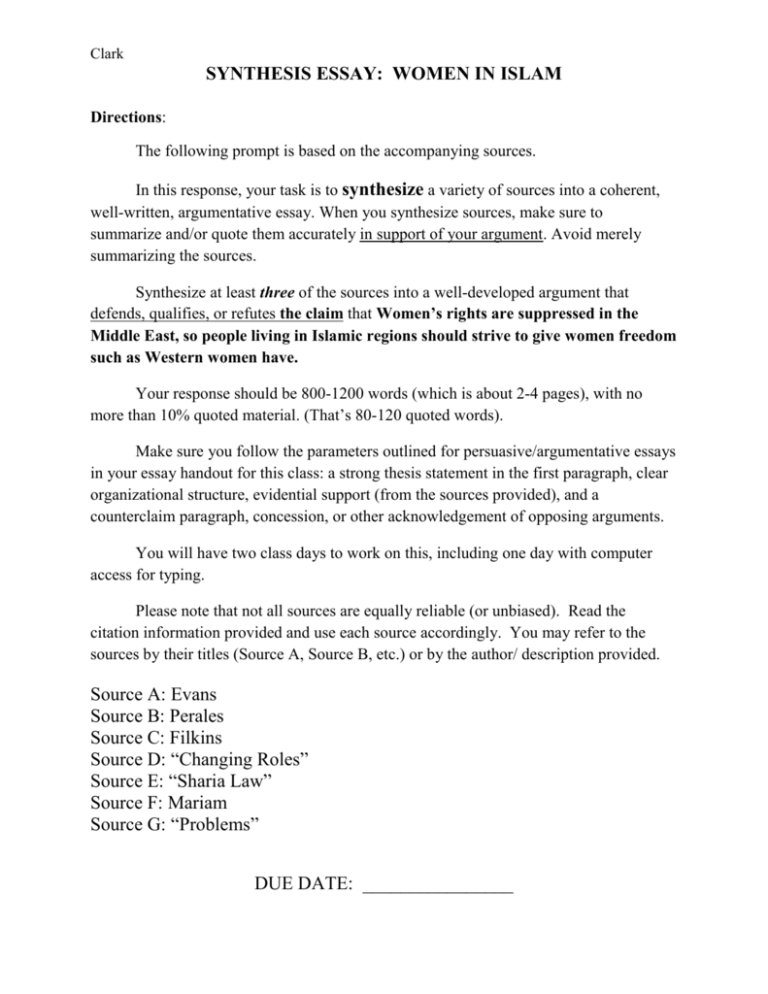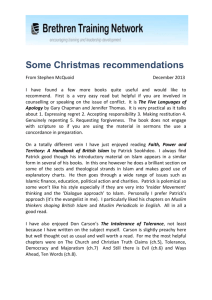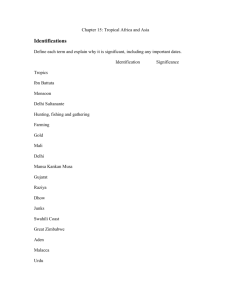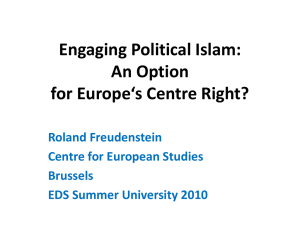
Clark
SYNTHESIS ESSAY: WOMEN IN ISLAM
Directions:
The following prompt is based on the accompanying sources.
In this response, your task is to synthesize a variety of sources into a coherent,
well-written, argumentative essay. When you synthesize sources, make sure to
summarize and/or quote them accurately in support of your argument. Avoid merely
summarizing the sources.
Synthesize at least three of the sources into a well-developed argument that
defends, qualifies, or refutes the claim that Women’s rights are suppressed in the
Middle East, so people living in Islamic regions should strive to give women freedom
such as Western women have.
Your response should be 800-1200 words (which is about 2-4 pages), with no
more than 10% quoted material. (That’s 80-120 quoted words).
Make sure you follow the parameters outlined for persuasive/argumentative essays
in your essay handout for this class: a strong thesis statement in the first paragraph, clear
organizational structure, evidential support (from the sources provided), and a
counterclaim paragraph, concession, or other acknowledgement of opposing arguments.
You will have two class days to work on this, including one day with computer
access for typing.
Please note that not all sources are equally reliable (or unbiased). Read the
citation information provided and use each source accordingly. You may refer to the
sources by their titles (Source A, Source B, etc.) or by the author/ description provided.
Source A: Evans
Source B: Perales
Source C: Filkins
Source D: “Changing Roles”
Source E: “Sharia Law”
Source F: Mariam
Source G: “Problems”
DUE DATE: ________________
Clark
SYNTHESIS ESSAY: WOMEN IN ISLAM
Grading: Essays will be scored holistically [as a whole rather than by individual traits]
according to the College Board’s AP guidelines. See the guidelines below. For the purposes of
scoring, synthesis refers to combining the sources and the writer’s position to form a cohesive,
supported argument and accurately citing all sources.
SCORING GUIDELINES FOR THE SYNTHESIS ESSAY
9:
100%
8:
95%
Effective
7:
85%
6:
75%
Adequate
5:
65%
4:
50%
Inadequate
3:
50%
2:
50%
Little
Success
1:
50%
0
Essays earning a score of 9 meet the criteria for essays that are scored an 8 and, in addition, are
especially sophisticated in their argument and synthesis of cited sources, or impressive in their
control of language.
Essays earning a score of 8 effectively take a position that defends, challenges, or qualifies the
claim. They effectively support their position by effectively synthesizing and citing at least
three of the sources. The writer’s argument is convincing, and the cited sources effectively
support the writer’s position. The prose demonstrates an ability to control a wide range of the
elements of effective writing, but is may not be flawless.
Essays earning a score of 7 fit the description of essays that are scored a 6 but are distinguished
by more complete or more purposeful argumentation and synthesis of cited sources, or a more
mature prose style.
Essays earning a score of 6 adequately take a position that defends, challenges, or qualifies the
claim. They adequately synthesize and cite at least three of the sources. The writer’s argument
is generally convincing and the cited sources generally support the writer’s position, but the
argument is less developed or less cogent than the arguments of essays earning higher scores.
Though the language may contain lapses in diction or syntax, generally the prose is clear.
Essays earning a score of 5 take a position that defends, challenges, or qualifies the claim that
television has had a positive impact on presidential elections. They support their position by
synthesizing and citing at least three sources, but their arguments and their use of cited sources
are somewhat limited, inconsistent, or uneven. The writer’s argument is generally clear, and the
sources generally support the writer’s position, but the links between the sources and the
argument may be strained. The writing may contain lapses in diction or syntax, but it usually
conveys the writer’s ideas adequately.
Essays earning a score of 4 inadequately take a position that defends, challenges, or qualifies
the claim. They attempt to present an argument and support their position by synthesizing and
citing at least two sources but may misunderstand, misrepresent, or oversimplify either their
own argument or the cited sources they include. The link between the argument and the cited
sources is weak. The prose of 4 essays may suggest immature control of writing.
Essays earning a score of 3 meet the criteria for the score of 4 but demonstrate less
understanding of the cited sources, less success in developing their own position, or less control
of writing.
Essays earning a score of 2 demonstrate little success in taking a position that defends,
challenges, or qualifies the claim. They may merely allude to knowledge gained from reading
the sources rather than citing the sources themselves. These essays may misread the sources,
fail to present an argument, or substitute a simpler task by merely responding to the question
tangentially or by summarizing the sources. The prose of essays scored a 2 often demonstrates
consistent weaknesses in writing, such as a lack of development or organization, grammatical
problems, or a lack of control.
Essays earning a score of 1 meet the criteria for the score of 2 but are especially simplistic or
weak in their control of writing or do not cite even one source
Essays earning a score of zero (0) are nonexistent, off-topic, unreadable, or merely repeat the
prompt.
Clark
SYNTHESIS ESSAY: WOMEN IN ISLAM
© 2006The College Board. All rights reserved. College Board, Advanced Placement Program, AP, and the acorn logo are registered trademarks
of the College Board.
SOURCE A:
Evans Cartoon
--Evans, Malcolm. "Cruel Culture." Cartoon. Evans Cartoons. Malcolm Evans, 6 Jan. 2011.
Web. 7 Mar. 2013.
Clark
SYNTHESIS ESSAY: WOMEN IN ISLAM
SOURCE B:
Perales
Islam is not a culture– it is a religion. Muslims are not a race– they are believers of
Islam. Muslim women are not oppressed– they are liberated.
“Simply plain ignorance,” says Jasmin Ali, UTHSC pre-med junior, “has misled
westerners to believe that Muslim women are oppressed.” Ali was born Muslim, but her
family converted before her birth. As a Muslim-American woman, she understands the
struggles of Muslim women in western society and culture.
One false belief is that Muslim women are required by patriarchal society to be
covered, which hinders them from being individuals. The truth is much different from the
common misconception that a veil is intended to segregate women from society. In actuality,
it is intended to protect them from society. According to Islam belief, Muslim women are
deemed to be of great importance and thus, highly protected.
Discovering that they were not born Muslim but converted to Islam may be shocking
to a misled westerner. The majority of the women who cover themselves whole heartedly
accept the covering and find it liberating. Although the Quran, the holy book of Islam, states
that women must cover, most Muslim women actually choose to cover themselves.
Some Muslim women choose to cover themselves more than the hijab allows. The
niqab allows a woman to cover her entire face except for her eyes.
“I hope to one day wear the niqab, Insha’Allah (God willing),” Mungia states, while
also mentioning she would like to wear the burqa, which is the complete full covering with
only a small screen that allows women to see through, “But in America, it is a bit more
shocking.”
“I like it… [but] personally would not wear a niqab because it would be hard to do
things in this country. If I moved to another country, I would definitely test it out,” said Ali.
Many westerners don’t fully understand that a half or full-face covering is not
required for Muslim women. The Quran requires women to cover everything except their
face, hands and feet; therefore, when a Muslim woman covers more than what is required, it
is typically her own choice and a form of protection.
Muslim women feel that respect is typically given to a woman wearing a covering. “It
feels good because you are treated in a respectful manner,” said Ali. She proceeds to tell
incidences of how American men tend not to look at her, open the doors for her and try to
avoid touching her or invading her personal space. That respect is the overall goal of a
Muslim woman who covers herself.
Some cultures and regions in the Middle East do, however, require women to wear a
full covering, such as a burqa, which covers the entire face with only a small screen for the
woman to see through. These are cultural limitations and are not always interpreted as a
religious requirement of Islam. According to Ali, cultural practices are acceptable, as long as
“[One] never turns cultural practices into Islam.”
Islamic education teaches a Muslim woman the importance of covering herself and
that modesty is important to show a sign of respect for God and Islam.
Excerpted from:
--Perales, Marcia. "Muslim Women at UTSA Explain Islamic Dress." The Paisano: UTSA's Independent
Student Newspaper. University of Texas San Antonio (UTSA), 19 Feb. 2013. Web. 06 Mar. 2013.
Clark
SYNTHESIS ESSAY: WOMEN IN ISLAM
SOURCE C:
Filkins
About 300 Afghan women, facing an angry throng three times larger than their own,
walked the streets of the capital on Wednesday to demand that Parliament repeal a new law
that introduces a range of Taliban-like restrictions on women, and permits, among other
things, marital rape.
It was an extraordinary scene. Women are mostly illiterate in this impoverished
country, and they do not, generally speaking, enjoy anything near the freedom accorded to
men. But there they were, most of them young, many in jeans, defying a threatening crowd
and calling out slogans heavy with meaning.
With the Afghan police keeping the mob at bay, the women walked two miles to
Parliament, where they delivered a petition calling for the law’s repeal.
“Whenever a man wants sex, we cannot refuse,” said Fatima Husseini, 26, one of the
marchers. “It means a woman is a kind of property, to be used by the man in any way that he
wants.”
The law, approved by both houses of Parliament and signed by President Hamid
Karzai, applies to the Shiite minority only. Women here and governments and rights groups
abroad have protested three parts of the law especially.
One provision makes it illegal for a woman to resist her husband’s sexual advances. A
second provision requires a husband’s permission for a woman to work outside the home or
go to school. And a third makes it illegal for a woman to refuse to “make herself up” or
“dress up” if that is what her husband wants.
The passage of the law has amounted to something of a historical irony. Afghan
Shiites, who make up close to 20 percent of the population, suffered horrendously under the
Taliban, who regarded them as apostates [A person who renounces a religious or political
belief (dictionary.com)]. Since 2001, the Shiites, particularly the Hazara minority, have been
enjoying a renaissance.
...
Afterward, when the demonstrators had left, one of the madrasa’s senior clerics came
outside. Asked about the dispute, he said it was between professionals and nonprofessionals;
that is, between the clerics, who understood the Koran and Islamic law, and the women
calling for the law’s repeal who did not.
“It’s like if you are sick, you go to a doctor, not some amateur,” said the cleric,
Mohammed Hussein Jafaari. “This law was approved by the scholars. It was passed by both
houses of Parliament. It was signed by the president.”
The religious scholars, Mr. Jafaari conceded, were all men.
Lingering a while, Mr. Jafaari said that what was really driving the dispute was the
foreigners who loomed so large over the country.
“We Afghans don’t want a bunch of NATO commanders and foreign ministers telling
us what to do.”
Excerpted from:
--Filkins, Dexter. "Afghan Women Defy Convention, and Crowds, to Protest New Law on Home Life."
The New York Times. The New York Times, 16 Apr. 2009. Web. 06 Mar. 2013.A version of this article
appeared in print on April 16, 2009, on page A1 of the New York edition.
Clark
SYNTHESIS ESSAY: WOMEN IN ISLAM
SOURCE D:
Changing Roles
Some Americans believe that Muslim women are oppressed by their religion,
forced to cover themselves completely, denied education and other basic rights. It is true
that Muslim women, like women all over the world, have struggled against inequality and
restrictive practices in education, work force participation, and family roles. Many of
these oppressive practices, however, do not come from Islam itself, but are part of local
cultural traditions. (To think about the difference between religion and culture, ask
yourself if the high rate of domestic violence in the United States is related to
Christianity, the predominant religion.)
In fact, Islam gives women a number of rights, some of which were not enjoyed
by Western women until the 19th century. For example, until 1882, the property of
women in England was given to their husbands when they married, but Muslim women
always retained their own assets. Muslim women could specify conditions in their
marriage contracts, such as the right to divorce should their husband take another wife.
Also, Muslim women in many countries keep their own last name after marriage.
The Quran explicitly states that men and women are equal in the eyes of God.
Furthermore, the Quran:
forbids female infanticide (practiced in pre-Islamic Arabia and other parts of the
world)
instructs Muslims to educate daughters as well as sons
insists that women have the right to refuse a prospective husband
gives women rights if they are divorced by their husband
gives women the right to divorce in certain cases
gives women the right to own and inherit property (though in Sunni Islam they get
only half of what men inherit. Men are expected to care for their mothers and any
unmarried female relatives, and would, it is reasoned, need greater resources for
this purpose.)
While polygyny is permissible, it is discouraged and on the whole practiced less
frequently than imagined by Westerners. It is more frequent in the Gulf, including
Saudi Arabia. Many Muslims cite the Quranic phrase "But treat them equally... and
if you cannot, then one [wife] is better" and argue that monogamy is preferable, or
even mandatory.
As the Islamic state and religion expanded, interpretations of the gender roles laid
out in the Quran varied with different cultures. For example, some religious scholars in
ninth- and 10th-century Iraq were prescribing more restrictive roles for women, while
elite women in Islamic Spain were sometimes able to bend these rules and mix quite
freely with men.
Some contemporary women -- and men as well -- reject the limitations put on
women and are reinterpreting the Quran from this perspective.
Excerpted from
-- "What Factors Determine the Changing Roles of Women in the Middle East and Islamic Societies?"
PBS. PBS, n.d. Web. 06 Mar. 2013.
Clark
SYNTHESIS ESSAY: WOMEN IN ISLAM
SOURCE E:
Sharia Law
Many advocates of Sharia cite Islam’s “fundamental respect for
women” as one of their religion’s greatest benefits. The prophet Mohammad
is known for ascribing women a right to own property, receive education, and
hold a job. When asked by an adherent whom he should give his greatest
respect to, Mohammad said, “your mother,” then “your mother,” then “your
mother,” only then followed by “your father” (here in the Compendium of
Muslim Texts).
Islam’s detractors take the opposite view: Muslim women are forced to
cover and hide themselves in public, the enforced segregation of sexes pushes
women into a second-tier status, and stricter interpretations severely limit
freedom in public life.
Saudi Arabia is notorious for not allowing women to drive or go out
alone in public, while in Malaysia Sharia’s role is, at least officially, limited
to advising on religious matters like marriage and divorce. In Turkey, the
constitution bans letting any religion’s laws form the basis of public policy.
In Somalia and Pakistan, serious incidents (like this woman who was
sentenced to death by stoning by Sharia courts after reporting that she was
raped) have drawn criticism by both critics of Islam and Muslims who say
that those judgments do not reflect the spirit of Sharia. The essence of Sharia
is hotly debated, going beyond just differences in interpretation between
Sunnis and Shiites to cultural practices and government regulations.
-- "Women's Rights Under Islamic Law." Inside Islam. University of Wisconsin and Wisconsin Public
Radio, n.d. Web. 06 Mar. 2013.
Clark
SYNTHESIS ESSAY: WOMEN IN ISLAM
SOURCE F:
Mariam
I was a teacher in a primary school, with a university degree, when the Taliban
captured Afghanistan in 1996. The Taliban did not allow women to go outside their homes
unless they were sick, and then they were not allowed to go alone to see a doctor. Outside,
they had to wear burqas. But one day I went out without wearing one. I had to accompany
my mother-in-law to a doctor's appointment, and my family owned just one burqa. I covered
my body with a big shawl and I covered my face. At a crossroads, we ran into some members
of the Taliban. I looked away with my eyes, but the Taliban began beating me. There was no
law to defend my rights as an Afghan woman. I thought that there was not any other choice
for me but to leave my country.
…
After the United Nations and United States helped create an Islamic republic in
Afghanistan, we returned to our country. I started a job in a different nongovernmental
organization that helps provide opportunities for rural women in order to raise their income
and their awareness about their role and rights. Women have the right to education, work,
and legal support. According to Afghanistan's constitution, every citizen who is at least 18
years old, male or female, has the right to vote. We are evidence of a big change.
Today, women can go everywhere, with permission from family. As an Afghan
woman, I have the permission of my husband to go alone outside of our country to attend
events and programs related to my job. We are in a Muslim country, and it is a basic
requirement of our religion to get this permission. I am very happy with my rights. Currently,
I am very happy with my life and my job.
But even while I talk about democracy, I think of all the crimes that I hear about on
the news every day. For example, there was 15-year-old Sahar Gul, rescued from the home
of her in-laws after being tortured for months. She had refused to be forced into prostitution.
And there are thousands of similar stories of Afghan women and girls, gloomy tales. But
why I am remembering such sad stories while I am talking of democracy and freedom?
Some of our people face problems because of security issues. Many of our problems
are caused by ignorance, misconceptions, and illiteracy. In city centers the problems are
fewer, but in remote areas there are a huge number of violent attacks against women. My
concern is that the Taliban will destroy our security and deprive women of their rights. I
think we need to work more through various programs and projects to provide awareness
about law.
We tolerated a lot of problems caused by decades of war in our country. Today there
are gains in education, construction, and civil rights, especially women's. There are
scholarship opportunities, employment opportunities, and so on. I don't want the United
Nations or the U.S. Army to leave Afghanistan after 2014. Please provide support for
Afghanistan in the upcoming election and for the establishment of a good policy to bring
peace and democracy in our country.
--Mariam [Surname withheld for safety]
--Norwan, Mariam, and Nasima. "Afghanistan in three voices: three Afghan women talk about violence
and shelter, the Taliban, and getting to vote." The Wilson Quarterly 37.1 (2013). Student Resources In
Context. Web. 7 Mar. 2013.
Clark
SYNTHESIS ESSAY: WOMEN IN ISLAM
SOURCE G:
Problems
“I operate daily under extremely dangerous situations in the south and southwest
regions of Afghanistan…. While there, I am
expected to be completely covered in a Burqa
and am advised to not carry a women’s style
handbag or laptop bag. My phone should be
off so that it is never heard ringing. Shaking
hands with men is a taboo and talking directly
about women’s rights could be punishable by
death. However, the secret behind my success
is that I am educated and have established
contacts with local elders – and I abide by all
these conditions. This is why I am able to run
my development projects successfully,” said
an Afghan woman who recently spoke to me
on condition of anonymity due to security concerns.
Under the Taliban’s regime, women endured unspeakably harsh conditions and were
deprived of basic rights. After the Taliban were overthrown in late 2001, the hope and
optimism of Afghan women was revived with a new presence of the international community
and international forces, and budding support for women’s participation in social,
economical, and cultural aspects of life.
Despite impressive efforts made since 2001, and some significant strides in education,
in many ways things remain extremely difficult for women. While some things are better, old
problems persist and new problems have presented themselves.
Findings from the chapter “Women and Society” from The Asia Foundation’s 2009
Survey of the Afghan People reveal
the biggest problems Afghan women
face. Education and illiteracy, tops
the list, followed by lack of job
opportunities and equal rights for
women (see graph below).
These problems are
interconnected and have reciprocal
effect on each other – making lasting
solutions even more difficult…
Given the country’s current
social, political, cultural, and
economical situation, there are a
variety of factors that exacerbate
these problems.
--Ayubi, Najla. "In Asia: Weekly Insight and Features from Asia." In Asia Womens Biggest Problems in
Afghanistan Comments. Asia Foundation, 27 Jan. 2010. Web. 07 Mar. 2013.









